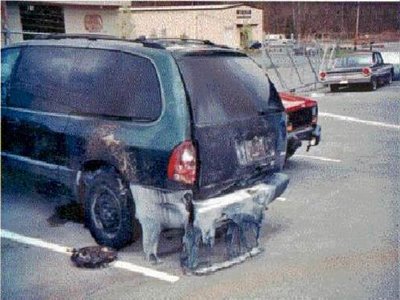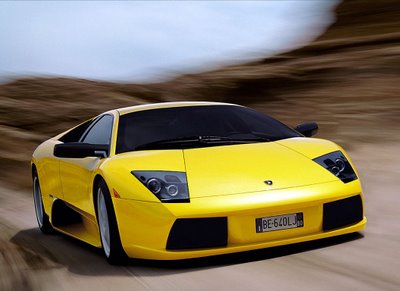Static Electricity Sparks Petrol Fumes
A Chrysler Voyager burned by petrol inflammed by static electricity.

As a continuation of the video
about static electricity in which a girl had a fire accident on getting out of her car and directly touching the nosepiece, we come across a similar case:
With the generalisation of self-service facilities in petrol stations people should be warned about the outbreak of fires resulting from static electricity while they are pouring in petrol.
150 cases of this type of fire have been investigated and the results were very surprising.
1. Of the 150 cases, more happened to women than men, due to their habit of getting in and out of the vehicle while the petrol is being poured in.
2. In the majority of cases the people had re-entered their cars when the hose was still pouring petrol out (the danger of the triggers on the nosepieces). When they finished refueling and got out to remove the hose pistol the fire began, as a result of the static electricity.
3. The majority of those affected used rubber-soled footwear and clothes of synthetic fibers.
4. Never use mobile phones when filling up with fuel.
5. It is well known that it is the vapor that comes from the petrol that burns and causes the fire when it makes contact with static charges.
6. In twenty-nine of the cases analysed, the people re-entered their vehicles and later touched the pistols during the petrol fuelling process. This happened in cars of different varieties of makes and models.
7. Seventeen fires occurred before, during or immediately after the cap of the petrol tank was removed and before starting to fill up with petrol.
8. The static charge often results from when a passenger rubs their clothes against the upholstery of the seats on getting in or out of the vehicle. To avoid this, it is recommendable that NOBODY gets in or out of the vehicle while the petrol is being poured in. Movement in or out should only be done BEFORE starting, or when the fuelling is finished and the petrol cap placed.
9. MAXIMISE THE PRECAUTIONS if the petrol has spilt or splashed onto the ground. Highly inflammable vapors are immediately produced which can be ignited by sparks of static electricity from the turning on of electronic equipment (mobile phones, remote controls, etc.) or by the ignition of the vehicle itself. BEFORE starting up the engine again, the spilt petrol must be gathered or neutralised by the petrol station staff.
LOADING PETROL
IN YOUR VEHICLE: Stop, put the handbrake on and turn off the engine, radio and lights.
NEVER: Return to your vehicle while you are pouring in fuel.
AS A PRECAUTION: Get used to closing the car door on getting out or into the vehicle and in this way the static electricity will be discharged on touching something metallic.
After closing the door TOUCH THE METAL PART OF THE BODYWORK before touching the petrol pump pistol. By doing this the static electricity in your body will be discharged on the metal and not on the pistol.
RESPECT THE SAFETY REGULATIONS
As mentioned, we undertake this as a daily task, both inside and outside the company. This bulletin aims to raise public awareness of this danger.
I urge you to send this information to ALL your friends and family, especially those carrying children in the cars when pouring in petrol. Thank you for passing on this information.

As a continuation of the video
about static electricity in which a girl had a fire accident on getting out of her car and directly touching the nosepiece, we come across a similar case:
With the generalisation of self-service facilities in petrol stations people should be warned about the outbreak of fires resulting from static electricity while they are pouring in petrol.
150 cases of this type of fire have been investigated and the results were very surprising.
1. Of the 150 cases, more happened to women than men, due to their habit of getting in and out of the vehicle while the petrol is being poured in.
2. In the majority of cases the people had re-entered their cars when the hose was still pouring petrol out (the danger of the triggers on the nosepieces). When they finished refueling and got out to remove the hose pistol the fire began, as a result of the static electricity.
3. The majority of those affected used rubber-soled footwear and clothes of synthetic fibers.
4. Never use mobile phones when filling up with fuel.
5. It is well known that it is the vapor that comes from the petrol that burns and causes the fire when it makes contact with static charges.
6. In twenty-nine of the cases analysed, the people re-entered their vehicles and later touched the pistols during the petrol fuelling process. This happened in cars of different varieties of makes and models.
7. Seventeen fires occurred before, during or immediately after the cap of the petrol tank was removed and before starting to fill up with petrol.
8. The static charge often results from when a passenger rubs their clothes against the upholstery of the seats on getting in or out of the vehicle. To avoid this, it is recommendable that NOBODY gets in or out of the vehicle while the petrol is being poured in. Movement in or out should only be done BEFORE starting, or when the fuelling is finished and the petrol cap placed.
9. MAXIMISE THE PRECAUTIONS if the petrol has spilt or splashed onto the ground. Highly inflammable vapors are immediately produced which can be ignited by sparks of static electricity from the turning on of electronic equipment (mobile phones, remote controls, etc.) or by the ignition of the vehicle itself. BEFORE starting up the engine again, the spilt petrol must be gathered or neutralised by the petrol station staff.
LOADING PETROL
IN YOUR VEHICLE: Stop, put the handbrake on and turn off the engine, radio and lights.
NEVER: Return to your vehicle while you are pouring in fuel.
AS A PRECAUTION: Get used to closing the car door on getting out or into the vehicle and in this way the static electricity will be discharged on touching something metallic.
After closing the door TOUCH THE METAL PART OF THE BODYWORK before touching the petrol pump pistol. By doing this the static electricity in your body will be discharged on the metal and not on the pistol.
RESPECT THE SAFETY REGULATIONS
As mentioned, we undertake this as a daily task, both inside and outside the company. This bulletin aims to raise public awareness of this danger.
I urge you to send this information to ALL your friends and family, especially those carrying children in the cars when pouring in petrol. Thank you for passing on this information.



8 Comments:
A little far-fetched...if static electricity could be that strong to start a fire...it could be a terrorist's tool!
To Joepsc: It's not exactly far-fetched. It can and does happen. But only under rare circumstances, it seems.
Dangerous petrol!
I better buy Toyota Prius that used electricity.
To Lao Xing Zhou: The petrol by itself is not dangerous. It's mixing static electricity and petrol fumes that can be lethal. Anyhow, the Toyota Prius still uses petrol, how ever little that might be. Afterall, it's a hybrid car and not entirely an electric one :)
At I pump only a few times per month as compared to full petrol cars.
Less chance to be burn.
Great info. I'm guilty as XXXX to go in and out of car while pumping. Now, wouldn't that make leaving kids in the car super dangerous? But how to lug all the kids out, and bring them all back??? Hmmm... have to figure it out.
ahhhhh I used to disbelieve the static elect bit until I got here, the air is so dry, everytime I touch something metal I get a jolt...
To Lao Xing Zhou: Yeah. Buying a hybrid car would mean your chances of starting a fire like that would be drastically reduced :)
To Mother Superior: It's okay for your kids stay inside the car. The static electricity only gets more charged up when a passenger gets in and out of the car repeatedly. The petrol fumes only get sparked into flames when they come into contact with your body's static. As long as you stay away from the pumping nozzle, you're safe :)
Post a Comment
Subscribe to Post Comments [Atom]
<< Home